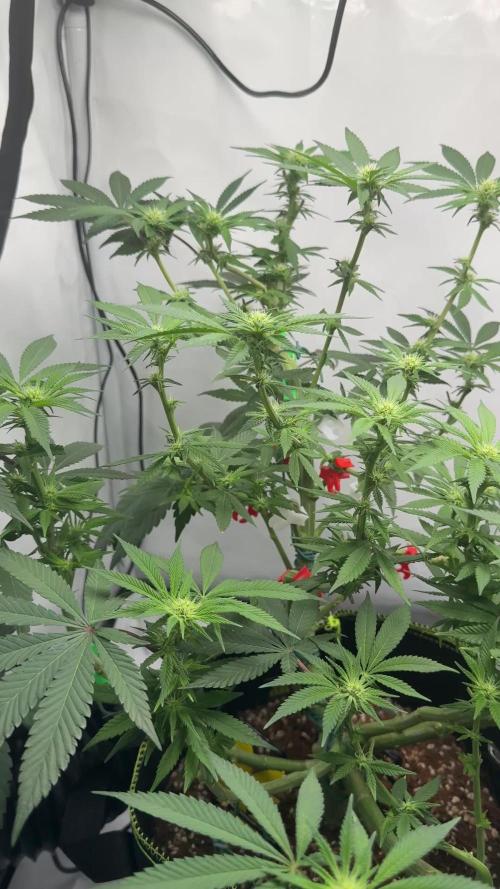The Grow Awards 2026 🏆 



























Likes
77
Share


@Basementganja
Follow
The final Week, before harvest! She has some massive towering buds!
2.5 gallons of water is lasting this plant 5-6 days before drying out, and ready for more.. She was harvested instead of being watered!
Likes
45
Share


@Philhsy
Follow
Added some great white, wanted to test, a bit late on but what ever,going to use next growmore correctly. The hures are amazong purplish red, trichromes that just starting to do their thing also an Amazing plant.
Likes
14
Share


@Chi_K24
Follow
hey guys, into week 10 and the start of the flowering phase. Getting closer to 12/12 and the ladies are starting to stretch.
Not much going on this week. A little bit of lst and the usual maint on the canopy.
Iv notice that some plants are having issues with brown/copper spots forming on some of the leafs edges. Hope someone can point me in the right direction.
Processing
Likes
26
Share


@eldruida_lamota
Follow
Buenos días familia, volvemos con la cuarta semana de floración con nuestras skunk de zambezaseeds y hay que recalcar que esta variedad tiene una rápida floración, apostaría Que será lo primero que cortemos.
El ph está controlado en 6.5 a partir de esta semana añadimos overdrive en nuestros riegos.
Temperatura y humedad ideales para la Avanzada etapa de floración.
Esta cepa es bastante resistente y Fácil de cultivar , os la recomendaría sobretodo a cultivadores novatos, y no tan novatos claro , ya que se valora mucho una floración rápida en indoor.
Likes
58
Share


@MadeInGermany
Follow
Info:
Unfortunately, I had to find out that my account is used for fake pages in social media.
I am only active here on growdiaries.
I am not on facebook instagram twitter etc All accounts except this one are fake.
Hello everyone :-)
Another nice week goes by.
In the next few days I will start training for the first time :-).
This week the water was poured twice with 0.8 l each (for nutrients, see nutrient table above).
Otherwise everything was checked and cleaned like every day.
Have fun with the update and stay healthy 🙏🏻
You can buy this Nutrients at :
https://greenbuzzliquids.com/en/shop/
With the discount code: Made_in_Germany you get a discount of 15% on all products from an order value of 100 euros.
You can buy this Strain at :
www.Zamnesia.com
Type:
Banana
☝️🏼
Genetics:
OG Kush x unkown
👍
Vega lamp:
2 x Todogrow Led
Quantum Board 100 W
💡
Bloom Lamp :
2 x Todogrow Led
Cxb 3590 COB 3500 K 205W
💡💡☝️🏼
Soil :
Canna Coco Professional +
☝️🏼
Nutrients :
Green Buzz Liquids :
Organic Grow Liquid
Organic Bloom Liquid
Organic more PK
More Roots
Fast Buds
Humic Acid Plus
Growzyme Big Fruits
Clean Fruits
Cal / Mag
Organic Ph - Pulver
☝️🏼🌱
Water:
Osmosis water mixed with normal water (24 hours stale that the chlorine evaporates) to 0.2 EC. Add Cal / Mag to 0.4 Ec Ph with Organic Ph - to 5.5 - 5.8 .
Likes
Comments
Share


@HOME_GROWBOOK
Follow
Der Stretch ist offiziell vorbei! Beide Sorten – 24K Gold und Gelato 33 – haben ihre Endhöhe erreicht und konzentrieren sich nun voll auf die Blütenproduktion.
Das Blätterdach steht dicht und gleichmäßig, alle Spitzen sind auf einer Ebene und perfekt im Lichtfeld.
24K Gold zeigt jetzt kräftige Blütenansätze an allen Haupt- und Seitentrieben. Ihre Tops sind bereits mit einem feinen weißen Flaum bedeckt, die Blütenstruktur wirkt kompakt und gleichmäßig.
Sie duftet bereits leicht süßlich mit einem typischen Kush-Unterton.
Gelato 33 präsentiert sich etwas buschiger mit engen Internodien. Ihre Blütenstände sind kleiner, aber sehr zahlreich – viele kleine Tops, die sich gleichmäßig entlang der Triebe bilden.
Das Blätterwerk bleibt sattgrün und gesund, keinerlei Anzeichen von Stress oder Nährstoffmangel.
Nach dem Entfernen des Netzes stehen die Pflanzen frei und stabil.
Eine gezielte Entlaubung wurde abgeschlossen, um Licht und Luft optimal zu verteilen.
Düngung & Setup:
• 💧 Canna Coco A + B → 6 ml/l
• 📈 EC 1.6 | pH 5.8
• 🌡️ 25–26 °C Tag / 21 °C Nacht
• 💧 Luftfeuchtigkeit 50 %
• 💨 Starke Umluft & stabile Tropfbewässerung
Der Übergang in die Hauptblüte verläuft absolut stressfrei – die Pflanzen sind gesund, vital und bereit, Masse aufzubauen.
Ab nächster Woche folgt der Fokus auf Blütendichte und Harzbildung – das spannendste Stadium beginnt jetzt!
Likes
6
Share


@gabigarcia
Follow
It is already the fifth week of vegetation and they are incredible, the autoflowering ones above all are beautiful and it is also noticing how the critical x are growing little by little. ! (Any questions, or any advice you can give me leave it in the comments, I also speak Spanish)
Likes
144
Share


@roro_204
Follow
I received the clones from An out of province breeder.
It reached me after three days of driving on the road with no light. Their future was not certain.
I didn’t think I would need that many fans for the clones because they are so tiny, I figured they didn’t need that much maintenance.
I was 100% wrong when I’m working with this many plants.
I ended up getting mild mildew on top of the soil on the first week because there was barely any air circulation.
At this point I didn’t have any Ventilation put up yet. And one fan on the floor. I ended up installing three fans in one room. No issues
Likes
13
Share


@Fidoe1
Follow
Good week for the girls..started way hot but has been getting cooler witch is great for flowering...they growing very fast now and have shot out meny new bud spots. My clones will db my yield and have been a great learning experience ...I have raise every kinda plant ..but these girls are a joy to grow... challenging ..frustrating .. but always a joy!
Likes
111
Share


@DreamIT
Follow
🍋🥧🏎️ LEMON PIE AUTO BY FAST BUDS 🏎️🥧🍋
🍋 26.2 Aware that decanting is not recommended for autoflowering, I made the last one, in a geotextile fabric pot, with Biobizz light mix soil. I rearrange the maininling to the @Canamatoes style (if you don't know it, look for it here on growdiaries, or on instagram, or on youtube and Facebook and twich). Irrigated with 1lt of water fertilized with HESI. yeah
🍋 27.2 ...
🍋 28.2 ...
🍋 1.3 ...
🍋 2.3 As expected, she has grown very little in these days after racking, but we don't get discouraged for so little :) in the meantime, more fast buds seeds have arrived that I can't wait to plant 😀
🍋 3.3
🍋 4.3 I had forgotten that these pots dry the soil quickly. today, 2.5 liters of fertilized water flowering scheme. They are 16 buds, I evaluate whether to double them again or keep it like this, suggestions are accepted: p
____________________________________________________________________________________
❌❓Not sure where to buy your seeds?
😮 Fast buds literally ships all over the world, check out their site!
http://bit.ly/FastBudsgood
__________________________________________________________________________________
📜 A look at the details of what I'm growing 📜
🍋🥧🏎️Lemon Pie Auto 🏎️🥧🍋
⚧ Gender
▪️ Feminised
➰ Genes
▪️ 50% Indica / 50% Sativa
🎄 Genetics
▪️ Lemon Pie X Autoflowering Genetics
🚜Harvest
▪️ 450 - 550 g / m²
🌱Vegetation
▪️30 - 35 days
🌷Flowering
▪️ 30-35 days
✨THC
▪️ 24.0%
✅CBD
▪️ 1.0%
🏡Room Type
▪️ Indoor
🌄Room Type
▪️ Outdoor
🕋Room Type
▪️ Greenhouse
🎂Release Year
▪️ 2020
__________________________________________________________________________
📷🥇 Follow the best photos on Instagram 🥇📷
https://www.instagram.com/dreamit420/
🔻🔻Leave a comment with your opinions if you pass by here🔻🔻
🤟🤗💚Thanks and Enjoy growth 💚🤗🤟
Likes
5
Share


@BasementGrowers
Follow
So flower has seemed very slow. We are on day 60 of flower, and they are NOT ready. The past two weeks the pH has been dropping tremendously every day. I couldn’t imagine it would be a root issue since I use hydroguard and we have a chiller set at 67 degrees, plus the plants look healthy! So I did my research and tried everything. Finally I decided to go ahead and treat with hydrogen peroxide because nothing else was helping, and Bam! Stable pH! Lesson learned. I hope the plants now start putting on weight over the next week and maturing. I was hoping to flush in a week, but I will just base it off what they are telling me.
Likes
8
Share


@Chupus
Follow
I planted two seeds, one on the ground, the second on a coconut. I want to check the difference .experiment.
Likes
11
Share


@WIKETFOLE
Follow
She has very nice smell already, I think his bloom will be very sticky and satisfying ,Already Its 5th week and she’s getting bigger and bigger.
Likes
29
Share


@HighZenBerg
Follow
Welcome back at week 3 in vegetative stage of the Sensi Amnesia feminized by Sensi Seeds.
She did a good progress during last week and developed 5 nodes already. I will give her a little more time before I top her and start the manifold.
She is very thirsty in her small pot. I think I will repot her in her final pot before I start mainlining.
So far, the conditions seems to fit. 26 C during day and 20 C at night with 50% humidity.
Leafs and new branches developed good and she is a strong lady without any issues.
Day 23: I repotted her into an 17 Liter pot with BioBizz Light Mix and it was absolutely necessary because the root mass of this lady was insane. Almost the whole pot was with white, healthy roots. I never experienced such a strong root structure in only 3 weeks from seed.
She will get 2 days of recovery time before I will top her.
Day 26: She got her second cut to develop 4 new main stems.
I started my first attempts in mainlining this lady. Hopefully she will recover fast and respond good to this technique.
Keep in touch !
Cheers HighZenBerg






























